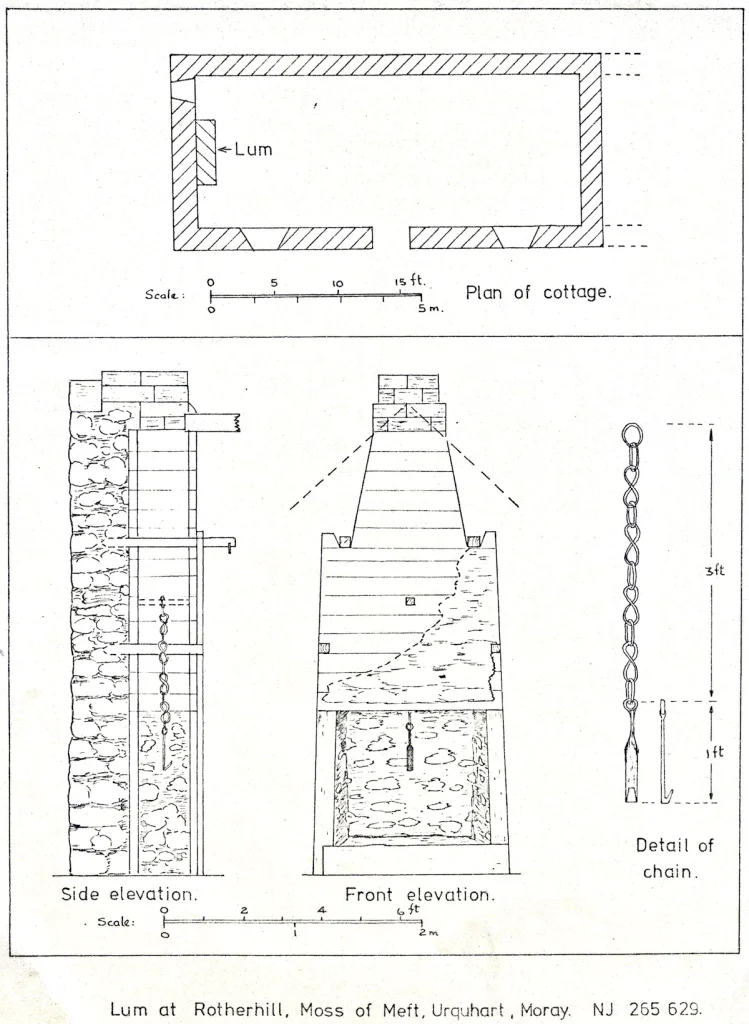Timmer Lum at Rotherhill
MFC Paper 26 by Elizabeth Beaton 1978
Smoke extraction by chimney posed some problems for the clay walled house, and those built of similar variants (2). No great difficulties arose with the central hearth, a fire lit in the middle of the house floor, with the smoke finding its way out via a central chimney or merely seeping through the thatch. Fireplaces on the gable end were an improvement on this, but in the case of the clay walled house it was not easy nor practicable to create a flue within the wall itself. The answer lay in an internal lum, combining chimney and canopy, erected against the gable wall, or cantilevered on it. These were known as "timmer lums" or, more precisely in the latter, "hingin' lums". (3)
One such timber lum is to be found in the old cottage at Rutherhill (NJ265629), Moss of Meft near Urquhart. Here is a small cottage, measuring overall 33'6" x 15', extending further to include the now ruined steading with cow byre which runs eastward along the same building line and which probably shared the same roofline.
The cottage is of roughly coursed clay and boole work, with a beaten earth floor and stone slabs paving the entrance. It has two small windows each side of the central doorway, one of which retains its original measurements of 2' x 2', and an even smaller one of 1'3" x 1'3" in the gable between the lum and the north wall. Even so small a light must have helped the "wifie" in her tasks at and by the single hearth, used both for cooking and heating. The cottage is now roofed with corrugated iron, both the original roofing material and its timbers having been replaced.
The west gable is dominated internally by the lum. The timber canopy front stands 8'6“ high and 5' wide, supported in front by two 8'6" posts and pegged into the walling by two pairs of horizontal stakes, of which the topmost pair protrudes 1' (one arm is broken away). These would have carried a line, from which both washing and fish were hung to dry (4).
Behind this front, which has been smoothly finished with a mud plaster, the lum rises up the height of the wall, narrowing from 5' x 1'8" at base to about 1'8" square at the chimney head. Internally the lum is entirely of wood, roughly sawn planks laid horizontally against posts and daubed with a mixture of clay and grass or straw, except for the lower side portion, the cheeks, which are of clay and boole. The present external chimney is made of brick, probably left over from the nearby railway bridge which spans this length of the Moray Coast Railway of the Great North of Scotland Railway, built in 1884. The original chimney would have been made of wood and mud. (5)
The rantle tree (6) is an iron bar running from wall to chimney front and from it hangs a blacksmith’s chain and hook to carry kettle or cooking pot. This chain is composed of iron figures of eight linked by iron rings, is cunningly made and is very worn. A large iron kettle still stands nearby,
Rutherhill cottage and steading appear on the 1870 O.S. 6" to l mile map (7) and seem to date from early or mid nineteenth century. It has been replaced by the larger, present Rutherhill, which stands at right angles, and which the old cottage now serves as a store.
I am grateful to the owners of Rutherhill the Rev. Dr. and Mrs. Stephen, for telling me of their cottage and lum and for their permission to visit at will, and to Mr. S.M. Ross for help with plans and drawings.
Notes
- Pride, Glen L. Glossary of Scottish Building, 1975. LUM. Chimney, the whole structure including fireplace, also wide wooden canopy suspended over fire serving as a smoke vent, part projecting above roof.
- Beaton, E., Moray Field Club paper No. 5, December 1975. Clay Building in the Lower Spey Valley.
- Beaton E. and Moran M. Vernacular Architecture Vol. 8 1977. A cottar house with a hingin' lum.
- There is a good photograph of this in the cookbook A taste of Scotland page 112. Theodora Fitzgibbon 1970. She obtained it from the Curwen Collection held by the National Museum of Antiquities, Edinburgh.
- A photograph which contains a wood and mud lum in Urquhart appears in Moray Past and Present by Mike Seton, published 1978 by Moray District Libraries.
- Pride, Glen L. 0p.cit. 1975 Railtree (rantle tree, ranneltree etc.) beam or bar of iron across chimney opening from which chain and hook for holding cooking utensils is suspended.
- Per Mr. Mike Seton and the map collection, Elgin Library.

